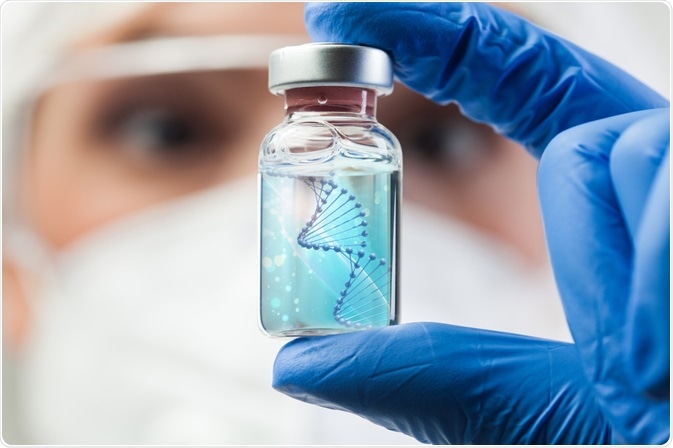The concept of a DNA vaccine was first proposed in 1990. Since then, DNA vaccines have been widely studied for their ability to induce both cellular and humoral immune responses against certain infectious agents.

DNA Vaccine. Image Credit: Cryptographer/Shutterstock.com
An overview of vaccinations
Vaccines are considered to be one of the most significant medical advancements in recent human history. In short, a vaccination stimulates the immune system so that it can recognize a contagion and neutralize it before any adverse effect occurs in the event that the vaccinated individual encounters the infectious agent in the future.
To elicit this immune response, a vaccination will either include the infectious agent itself, or certain components of the infectious agent, either of which has been modified to ensure that no harm or disease is caused to the patient upon exposure to the agent in this form.
Despite the importance that vaccinations have had throughout most of the world, there are certain challenges that scientists continue to face during the development of novel vaccines. These challenges are due to several different factors, such as high development costs and extensive time requirements to reach clinical testing. While these challenges still exist in the vaccine development process, the increased occurrence of both new and reemerging infections has demonstrated the need to create vaccines in a faster and simpler way.
What are DNA vaccines?
Deoxyribonucleic acid (DNA) vaccines have the potential to address many of the concerns surrounding conventional vaccine development approaches. In general, a DNA vaccination will use DNA particles of the target pathogen to induce an immune response.
In addition to this approach, several subtypes of DNA vaccines have also been studied. A plasmid DNA vaccine, for example, will contain a plasmid of the DNA sequence that encodes for the antigen against which the immune response will be targeted against.
Once injected through either intramuscular (IM) or, more recently, intradermal (ID) inoculation, the plasmid DNA will be taken up by a certain number of cells surrounding the site of injection.
From here, the plasmid DNA enters the nucleus of human cells, where it is transcribed into messenger ribonucleic acid (mRNA) and translated into the antigen within the cell. The synthesized antigen produced during this process, which can remain active for several months following the inoculation, will then activate the immune response through major histocompatibility complex (MHC)-I and MHC-II pathways.
Improving the immunogenicity of DNA vaccines
When the first generation of DNA vaccines was introduced, they had limited immunogenicity, particularly when used in non-human primates and human test subjects. In an effort to improve the overall immunogenicity of this novel vaccination technology, several strategies have been developed.
Adjuvants
The co-delivery of DNA vaccines with DNA-encoded cytokine adjuvants such as interleukin 12 (IL-12), for example, has successfully enhanced the co-stimulation of antigen-presenting cells (APCs) following inoculation.
Several other adjuvants have been used to enhance the duration of immune protection by DNA vaccines, some of which include molecular immunostimulants like polysaccharides, proteins, polymers, and nucleic acids, as well as advanced vaccine particles like virus-like particles, microparticles, and nanoparticles.
Physical methods
The development of adaptive electroporation (EP) strategies has produced particularly promising results, as immune responses have been found to be both more potent and more consistent when EP approaches are used. In short, EP increases plasmid DNA uptake into host cells by inducing the development of transient pores within the plasma membrane of these cells.
By increasing the initial intake of plasmid DNA by local cells, adaptive EP increases the immunogenicity of DNA vaccines by up to 500 times that of conventional DNA vaccines. This increase in local transfected cells leads to a subsequent rise in the number of transfected APCs that are brought to the lymph nodes, thereby directly enhancing the immune response.
Adaptive EP is one of many physical methods that have been proposed to increase plasmid DNA delivery in DNA vaccines. Other physical methods include the gene gun which assists in delivering plasmids epidermally without requiring a needle, impalefection, which involves the physical puncturing of local cells by microneedles, hydrostatic pressure that squeezes cells into a microfluidic chamber, intranasal delivery, and sonoporation.
Advantages
As compared to traditional vaccines, such as those that consist of viral vectors, DNA vaccines comprised of synthetic DNA are highly stable, thereby eliminating the need for cold chain transport or storage requirements. This advantage alone facilitates the global deployment of vaccines, particularly in rural areas that are not equipped with the refrigeration technologies needed to store most conventional vaccines.
In addition to improved vaccine stability, other advantages associated with DNA vaccines include their ability to stimulate both B- and T-cell responses, simple manufacturing requirements that can easily be transformed to a larger scale, as well as the absence of any infectious agent within the vaccine.
Although many of the aspects of the immune response generated by DNA vaccines have yet to be fully understood, their use in clinical trials continues with the goal of preventing infectious diseases from harming humans in the future.
References:
- DNA vaccines [Online]. Available from: https://www.who.int/teams/health-product-and-policy-standards/standards-and-specifications/vaccines-quality/dna.
- Gary, E. N., & Weiner, D. B. (2020). DNA vaccines: prime time is now. Current Opinion in Immunology 6; 21-27. doi:10.1016/j.coi.2020.01.006.
- Xu, Z., Patel, A., Tursi, N. J., et al. (2020). Harnessing Recent Advances in Synthetic DNA and Electroporation Technologies for Rapid Vaccine Development Against COVID-19 and Other Emerging Infectious Diseases. Frontiers in Medical Technology. doi:10.3389/fmedt.2020.571030.
- Lee, J., Kumar, S. A., Jhan, Y. Y., & Bishop, C. J. (2018). Engineering DNA vaccines against infectious diseases. Acta Biomaterialia 80; 31-47. doi:10.1016/j.actbio.2018.08.033.
- Abdulrahman, A., & Ghanem, A. (2018). Recent advances in chromatographic purification of plasmid DNA for gene therapy and DNA vaccines: A review. Analytica Chimica Acta 1025; 41-57. doi:10.1016/j.aca.2018.04.001.
Further Reading
Last Updated: Jan 17, 2022